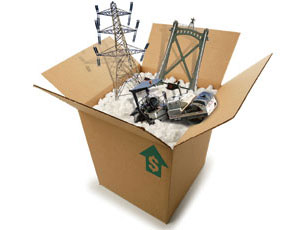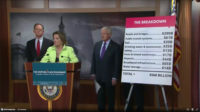As the $787.2-billion American Recovery and Reinvestment Act (ARRA) nears its two-month mark, federal agencies are picking up the pace in parceling out the measure’s estimated $130 billion for construction-related projects. The flow of funds, however, has been uneven. The Dept. of Transportation is in the fore-front obligating $4.7 billion in stimulus aid as of March 31. Most of that has gone to state highway agencies, which have begun to commit money and award construction contracts for specific projects.

But other agencies, including the Dept. of Veterans Affairs and General Services Administration, only recently released lists of projects that they intend to fund through the stimulus. Contract awards still lay in the future.
For construction companies and workers, the stimulus money cannot come soon enough. The industry lost another 126,000 jobs in March, bringing the total construction job losses to 466,000 since November, the Labor Dept. reported on April 3. That pushed construction’s March unemployment rate in March to 21.1%, from 12.0% a year earlier.
Capitalizing on the stimulus package is a complicated task. Construction companies seeking detailed funding or contract information cannot simply knock on one federal door to find all the answers. Some of the statute’s requirements do apply across the board, but funding allotments differ from agency to agency, as do some mandates and deadlines. Federal agencies themselves are digesting implementing directives from the Office of Management and Budget and federal procurement officials.
“We don’t have an unrestricted flow of money. We’ve got some clots and clogs in the financial artery system,” says Stephen E. Sandherr, the Associated General Contractors’ CEO. He notes that one such blockage is the law’s “Buy American” provision, which requires stimulus-funded projects to use only “iron, steel and manufactured goods...produced in the U.S.” That language has delayed some projects “because people don’t know how to apply it,” says Sandherr.
The statute allows federal agency heads to waive the Buy American mandate on several grounds, including “the public interest.” On April 1, the Environmental Protection Agency issued a nationwide Buy American waiver for drinking-water and wastewater treatment projects whose debt financing was incurred between Oct. 1, 2008, and Feb. 17. EPA said imposing the Buy American requirement “would...entail time-consuming delay and thus displace the ‘shovel ready’ status of these projects.”
EPA’s waiver may not help a wastewater treatment project in Conrad, Mont., stalled because of Buy American questions. Rep. Dennis Rehberg (R-Mont.) on April 1 asked OMB Director Peter Orszag to issue guidance to clarify the Buy America language. Rehberg said many projects in his state, including the one in Conrad, “are having difficulty getting American-made certifications for specialty equipment that is not readily available in the market.”
Overall, agencies are making progress, says OMB Deputy Director Robert Nabors II. He told the Senate Homeland Security and Governmental Affairs Committee on April 2 that 15 agencies had issued funding-obligation notices by early April. “For the most part, the agencies are still in the planning stage,” said Nabors. But, he added, “We will see increased grants, loans and contracts being made going into the summer and fall.”
“There are a number of programs that are working really well,” says Jim Berard, House Transportation and Infrastructure Committee spokesman. State highway agencies “were racing each other, literally, to get shovels in the ground,” he says. Jack Basso, American Association of State Highway and Transportation Officials’ director for programs, finance and management, agrees. “All in all I think [highways] is going extremely well and very smoothly and very efficiently,” he says.
| Top 10 projects | ||
|---|---|---|
| 1. | Washington, D.C. Commerce Dept. HQ- Herbert Hoover Bldg. (Phase II and Ill) | 225.6 |
| 2. | Denver, Colo. Byron Rogers Federal Building | 167.6 |
| 3. | Washington, D.C. GSA HQ (Phase I) | 161.3 |
| 4. | Newark, N.J. Peter Rodino Federal Building | 146.1 |
| 5. | Portland, Ore. Edith Green-Wyndell Wyatt Federal Building | 133.1 |
| 6. | Washington, D.C. Ex-Im Bank, VA-Lafayette Bldg., (Phase I) | 128.8 |
| 7. | Cleveland, Ohio A.J. Celebrezze Federal Building | 121.5 |
| 8. | San Francisco, Calif. 50 United Nations Plaza | 121.0 |
| 9. | Honolulu, Hawaii Prince Kuhio Kanaianaole Federal Building-Courthouse (Phase I) | 121.0 |
| 10. | Andover, Mass. IRS Service Center | 117.0 |
| Source: GSA | ||
One plus for the highway program is its “easily identified formula” for distributing the money, Sandherr says. Another factor is ARRA’s stringent “use it or lose it” provision, requiring states to obligate half of their highway dollars within 120 days of DOT's apportioning the funds, adds Basso.
Other agencies are moving out of the blocks. GSA on March 31 released a list of projects it plans to finance with stimulus aid. A large number of those projects exceed $50 million. The Dept. of Defense’s $5.9-billion program, released on March 20, has mostly small projects.
VA posted its $1.3-billion stimulus lineup on April 2-3. Like DOD, VA is concentrating mostly on smaller projects, many pegged at less than $1 million. VA has nearly $1.1 billion for 965 “non-recurring maintenance” and energy-related projects, $150.9 million to build or expand extended-care facilities and $50 million for work at national cemeteries.
Still to come is the Army Corps of Engineers’ plan, expected on May 1. “Some [agencies] have not moved as fast as we had hoped, but we are pretty confident...they will catch up,” says Berard.
States already have started to create transportation jobs using stimulus money, but construction is seeing “depression-level job loss,” says Jacob Hay, spokesman for the laborers’ union. “Even after the economic recovery package creates the expected 700,000 construction jobs, there will still be more than 1.2 million construction workers unemployed.”
| Federal Buildings and U.S. Courthouses | |
|---|---|
| San Juan, Puerto Rico FBI Field-Office Consolidation | 42.7 |
| Jackson, Miss. U.S. Courthouse (cost escalation) | 5.0 |
| Austin, Texas U.S. Courthouse | 116.0 |
| El Paso, Texas U.S. Courthouse (cost escalation) | 2.0 |
| Little Rock, Ark. U.S. Courthouse (cost escalation) | 7.0 |
| Billings, Mont. U.S. Courthouse | 80.0 |
| Bakersfield, Calif. U.S. Courthouse | 31.1 |
| Washington, D.C. DHS Consolidation and Development of St. Elizabeths Campus | 222.5 |
| Washington, D.C. St. Elizabeths West Campus Infrastructure | 223.4 |
| Washington, D.C. St. Elizabeths West Campus Site Acquisition | 4.0 |
| TOTAL FUNDING | 733.7 |
| Border Stations and Land Port of Entry | |
| Calais, Maine U.S. Land Port of Entry (cost escalation) | 6.3 |
| Madawaska, Maine U.S. Land Port of Entry | 0.8 |
| Van Buren, Maine U.S. Land Port of Entry | 39.7 |
| Columbus, N.M. U.S. Land Port of Entry | 2.4 |
| Nogales, Ariz. Nogales West U.S. Land Port of Entry | 199.5 |
| Otay Mesa, Calif. U.S. Land Port of Entry | 21.3 |
| Blaine, Wash. Peace Arch U.S. Land Port of Entry (cost escalation) | 30.0 |
| TOTAL FUNDING | 300.0 |
| Source: GSA | |



Post a comment to this article
Report Abusive Comment